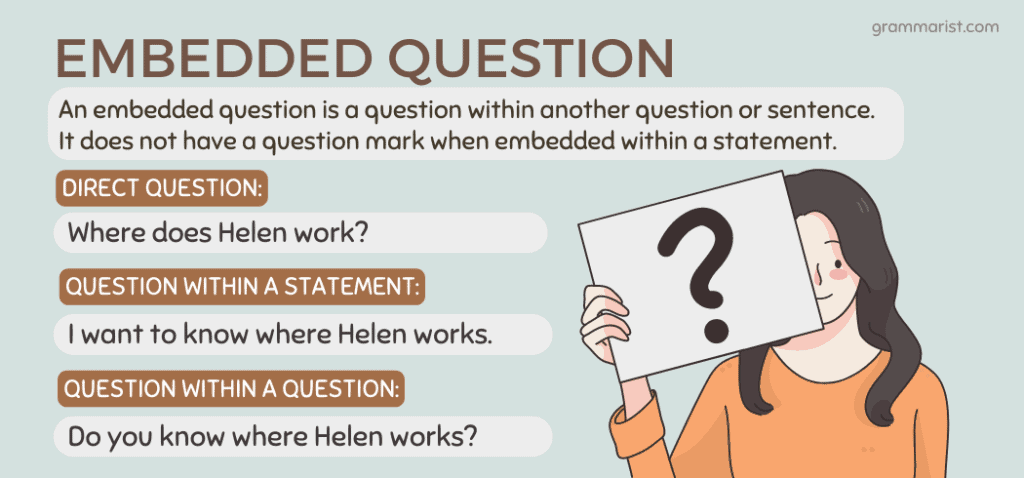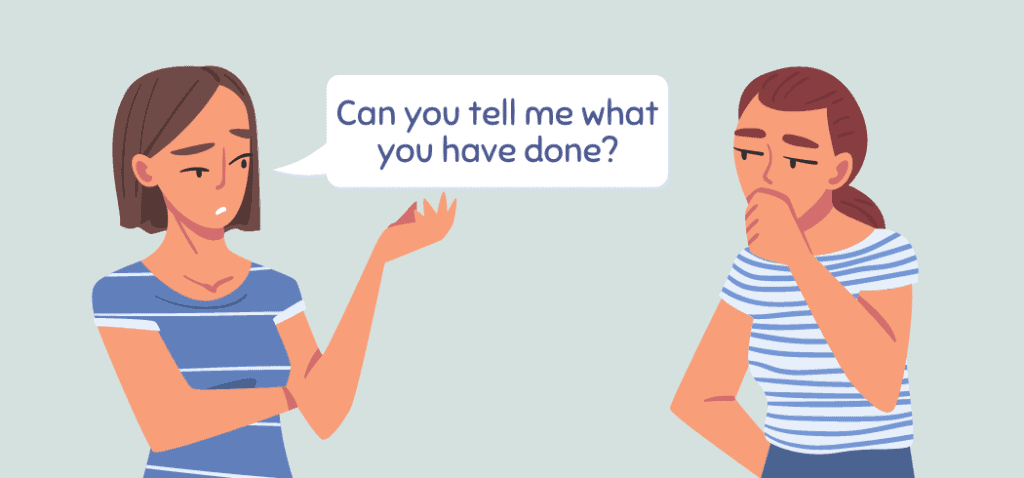Many English speakers need help forming embedded questions because the structure of these questions differs from the typical what, when, who, where, and why sentences. If that’s you, I’m here to help!
An embedded question is defined as a question within another statement or question. For instance, the embedded question version of “How is she?” is “I wonder how she is.”
To help you form embedded questions, I’ll show you its definition and structures in English grammar. Once you’ve mastered the topic, answer the worksheet I left at the end of the article.
What Is an Embedded Question?

In English grammar, an embedded question is a question within another question or sentence.
It is different from other types of questions that start with wh- words because they do not have auxiliary verbs. An embedded question does not have a question mark when embedded within a statement.
Embedded questions are not direct questions. For instance, instead of asking the normal question, “Is Candace sick?” you can say, “I wonder if Candace is sick.” You can also say, “Can you tell me if Candace is sick?”
The question clauses can be used similarly to how you’d use a noun. For example, “if Candace is sick” in “I wonder if Candace is sick” functions as a direct object. But in question sentences “Is Candace sick?”, question clauses as nouns do not exist.
Embedded sentence examples:
- Direct question: Did you arrive safely?
- Embedded question: I wanted to ask if you arrived safely.
- Embedded question: Could you tell me if you arrived safely?
- Direct question: Where does Helen work?
- Embedded question: I want to know where Helen works.
- Embedded question: Do you know where Helen works?
Embedded Questions Structure
We use normal sentence grammar for embedded questions. That means they follow a subject-verb-object pattern instead of the typical inverted pattern for actual questions.
Question Within a Statement
For an indirect question within a statement, the correct sentence structure is:
- Introductory phrase + question word + embedded question
This construction makes the sentence a declarative statement. Some examples of introductory phrases include I asked, I wonder, and I don’t know. Other examples of verbs you can use include tell, mind, question, and like to know.
Here are some examples of statement questions.
- I wonder who left these cookies.
- I don’t know where she went.
Notice how the sentences do not have an auxiliary verb or a question mark. Here are more examples of statements.
- I don’t know what she’s doing.
- Let’s find out what his email means.
- I don’t know who this phone belongs to.
- The question is whether Ross should enroll in a different school.
- I wonder if she’s coming.
In the last sentence, the conjunction if can be replaced with whether.
Question Within a Question
There are two ways to form an embedded question within another question.
- Info question: Introductory question + question word + subject + auxiliary verb
- Yes/no question: Introductory question + if/whether + subject + auxiliary verb
Here are some examples of embedded questions within another question.
- Info question: Can you explain why you’re quitting law school?
- Yes/no question: Can you tell me if Rica is attending today?
In the second sentence, the conjunction if can be replaced with whether.
Here are more examples of questions within questions.
- Who knows what page we need to read?
- Do you know who took the money?
- Could you share what happened during the meeting?
- Does Julia know where you went?
- Would you mind telling me where the gasoline station is?
Embedded Questions and Verb Tenses

These sentences show how to express the correct verb tenses when transforming direct questions into embedded questions.
Simple Present
- Direct question: What do you do for a living?
- Embedded question: Can you tell me what you do for a living?
- Direct question: Are you happy?
- Embedded question: Does she know if you’re happy?
Simple Past
- Direct question: Did you notice his smile?
- Embedded question: Could you tell me if you noticed his smile?
Present Perfect
- Direct question: What have you done?
- Embedded question: Can you tell me what you have done?
Simple Future
- Direct question: Will you be at the cafe later?
- Embedded question: Could you tell me if you will be at the cafe later?
Future Continuous
- Direct question: Are you taking her out tomorrow?
- Embedded question: Can you tell me if you are taking her out tomorrow?
Modal Should
- Direct question: Should we cook pasta?
- Embedded question: Do you know if we should cook pasta?
When to Use Embedded Questions
Use embedded questions to give more information. For instance, saying “Are you happy?” is a neutral question. But “I wonder if you’re happy” shows additional information that the speaker is curious about.
Another function of embedded questions is to become more polite. Instead of asking “What time is she arriving?” to an acquaintance, you can say, “Could you please tell me what time she’s arriving?”
Embedded Questions and Contractions
Most direct questions have contractions at the beginning of the sentence. For example:
- Who’s she?
- What’s her name?
Don’t use contractions at the final part of an embedded clause. For example:
- Incorrect: Do you know where they’re?
- Correct: Do you know where they are?
Use Embedded Questions in Your Writing
An embedded question is not a direct question because it does not follow the normal inverted question pattern. Instead, these types of questions are questions within questions or questions in statements. I hope my guide has helped explain that in a way you understand.
I’d suggest you use embedded questions to sound more polite to strangers or acquaintances. You can also use them to add more information to the question through an introductory phrase.
